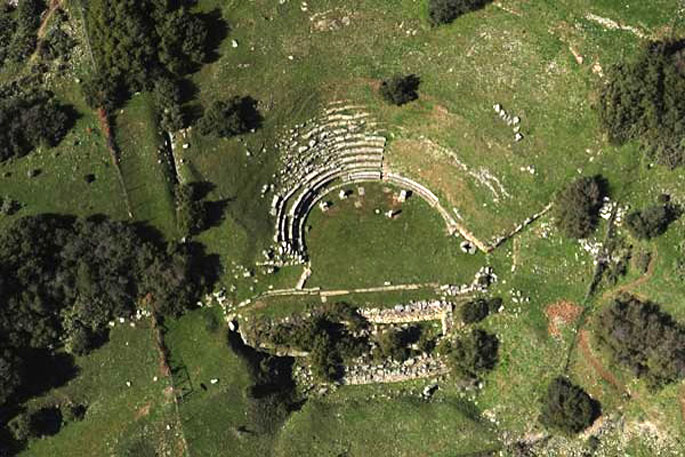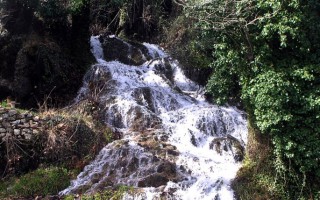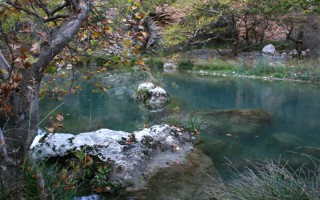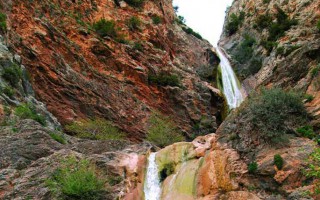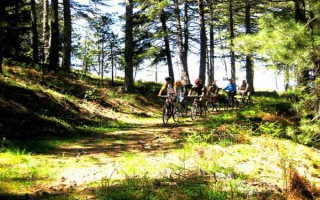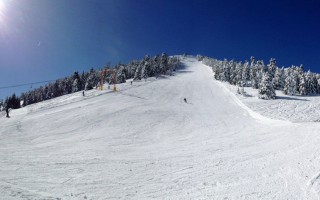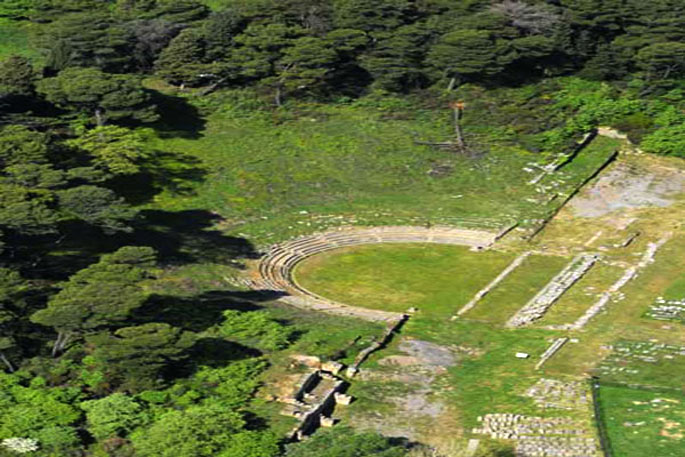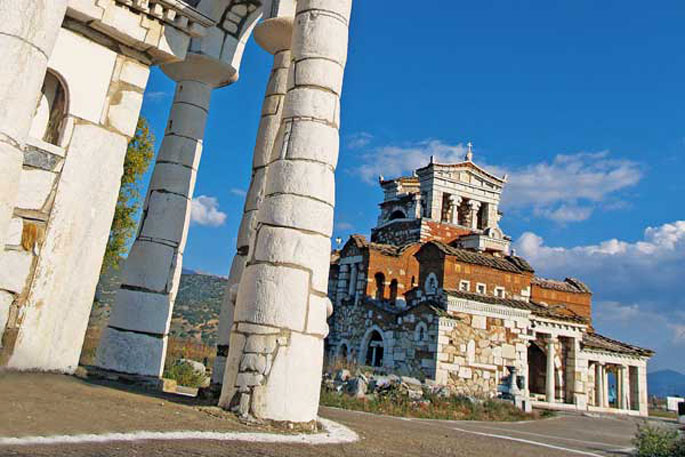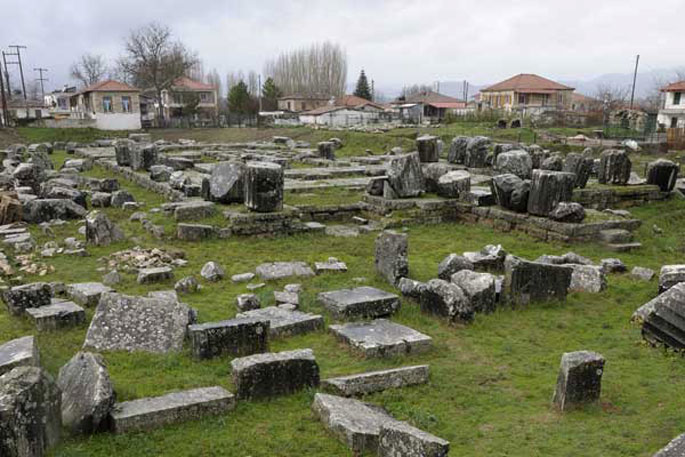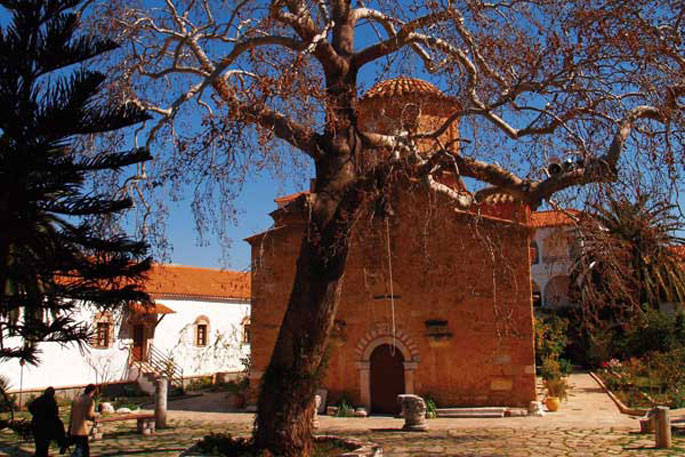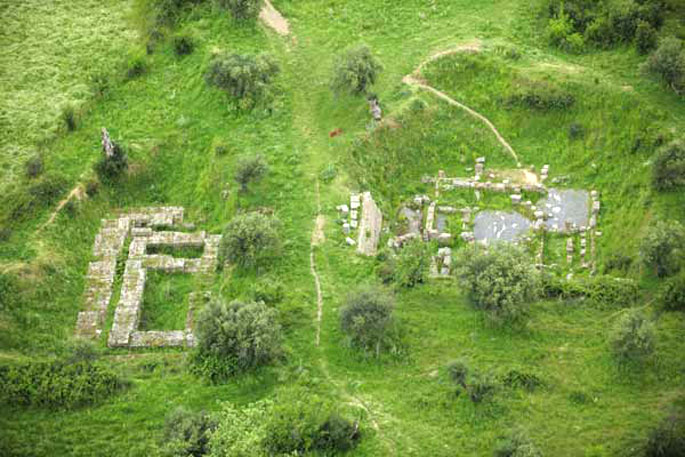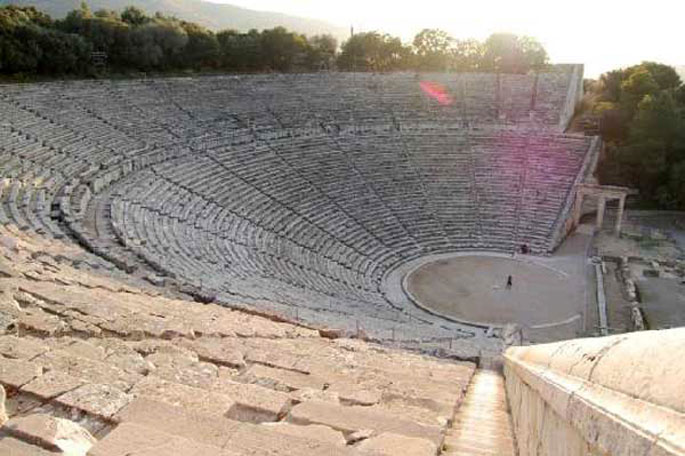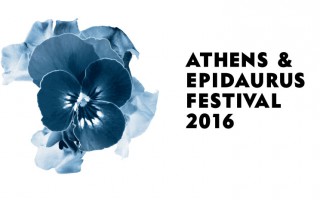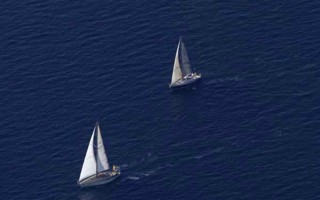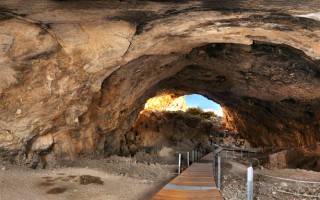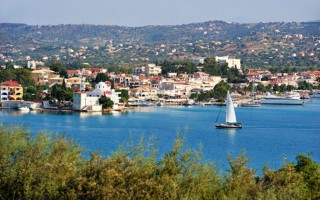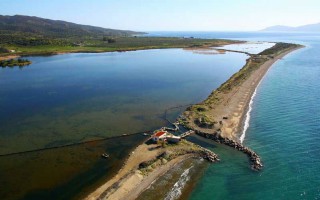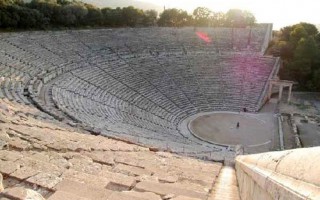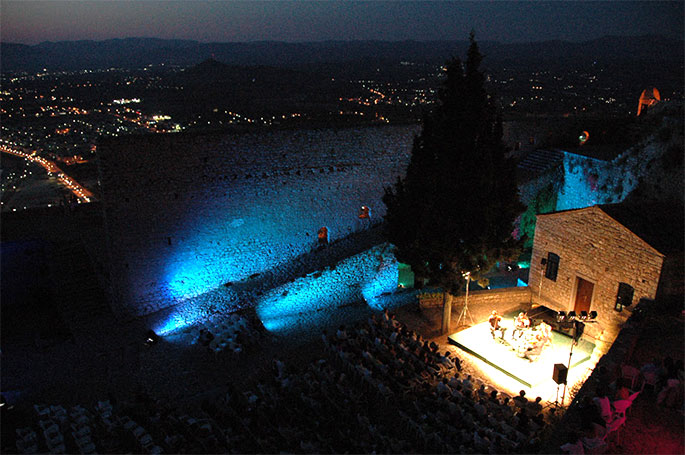Orchomenus was a city in ancient Arcadia, its ruins today situated approximately 30 kilometres from Tripoli, a small distance outside the village of Levidi.
Orchomenus was one of the oldest cities in the region, with evidence of prehistoric inhabitation. It had a large population, as well as a significant presence in the events of the time, and there are testimonies that it was a particularly rich city, since it struck its own coin. Orchomenus was one of the three “large powers” of eastern Arcadia, together with Tegea and Mantineia, with both of which, in fact, it was in constant opposition. Its greatest peak was during the Archaic period, circa the 7th and 6th centuries BC. The city was abandoned during the Roman and Byzantine years, and its inhabitants relocated to the surrounding regions.
The main city is situated on a hill dominating the valley of Levidi and Kandila, an impressive – as well as strategic – position, as it allowed control of the region over a fairly large distance. This ancient city has been excavated and is now open to visitors. The first systematic excavations took place in 1913 by G. Blum and A. Plassart, while during the years 1973-1976 new excavations were carried out by the Supervisory Service of the Prefecture of Arcadia, the 5th Ephorate of Prehistoric and Classical Antiquities, under the direction of its former Head, G. Stainhower. Further works were carried out in 1980 under the direction of former Head, Th. Spyropoulos.
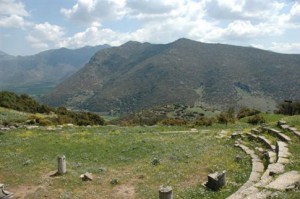 Among the monuments brought to light are a bridge dating to the Archaic period, a prehistoric tomb, the ancient agora, the bouleuterion, a temple to Artemis Mesopolitis, its walls, and most importantly the ancient theatre, one of the largest theatres of the ancient times, with a capacity for 4,000 people, built during the Hellenistic period, in the 3rd century BC. This theatre, built at an altitude of 800 metres, offered a unique view. It was used both for plays and for games in honour of the god Dionysus. An interesting fact is that, as this theatre was built on a steep slope, it had a system for draining rainwater, which consisted of separate stone drainage pipes.
Among the monuments brought to light are a bridge dating to the Archaic period, a prehistoric tomb, the ancient agora, the bouleuterion, a temple to Artemis Mesopolitis, its walls, and most importantly the ancient theatre, one of the largest theatres of the ancient times, with a capacity for 4,000 people, built during the Hellenistic period, in the 3rd century BC. This theatre, built at an altitude of 800 metres, offered a unique view. It was used both for plays and for games in honour of the god Dionysus. An interesting fact is that, as this theatre was built on a steep slope, it had a system for draining rainwater, which consisted of separate stone drainage pipes.
Source: www.mythicalpeloponnese.gr
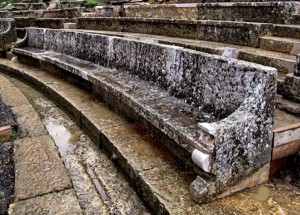 Three kilometres outside modern-day Megalopoli, in close proximity to the road leading from Megalopoli to Karytaina, lies the archaeological site of Megali Polis, one of the most magnificent cities of ancient Arcadia which, despite this, did not manage to survive for more than two centuries. The archaeological site contains ruins of the ancient agora, the Thersileion parliament hall on the north side, with a capacity of approximately 16,000, as well as the largest and oldest theatre of Ancient Greece, situated across from the agora and connected to it by a bridge.
Three kilometres outside modern-day Megalopoli, in close proximity to the road leading from Megalopoli to Karytaina, lies the archaeological site of Megali Polis, one of the most magnificent cities of ancient Arcadia which, despite this, did not manage to survive for more than two centuries. The archaeological site contains ruins of the ancient agora, the Thersileion parliament hall on the north side, with a capacity of approximately 16,000, as well as the largest and oldest theatre of Ancient Greece, situated across from the agora and connected to it by a bridge.
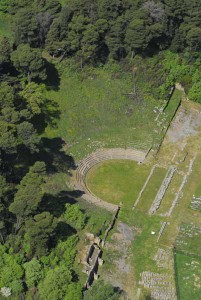 The theatre was constructed by Polycleitus of Argos, circa 370 BC, and had a capacity of around 20,000 spectators and perfect acoustics. The reason its proportions were so large was that, in addition to theatre, it also hosted meetings of a political nature between the 40 Arcadian cities that comprised Megalopolis, which could be attended by any interested citizen. A wooden stage with wheels was used for plays, which was kept at the scenotheque (the stage store) and would be pulled out to the theatre whenever needed. The theatre’s peak is placed in the 3rd century BC, and coincides with the peak period of Megali Polis. The theatre first started to come to light in the late 19th century. The British Institute started excavations in the region in 1890-1891, which revealed the proscenium, orchestra, part of the proedria, the analemma walls of the parodoi, the foundations of the scenotheque and the lower stone seats. Research is still underway at the Thersileion parliament hall site, and new results are expected. The ancient theatre of Megalopolis is part of a European programme financed by UNESCO. The goal is to carry out the necessary restoration works that will further highlight the importance of this ancient monument.
The theatre was constructed by Polycleitus of Argos, circa 370 BC, and had a capacity of around 20,000 spectators and perfect acoustics. The reason its proportions were so large was that, in addition to theatre, it also hosted meetings of a political nature between the 40 Arcadian cities that comprised Megalopolis, which could be attended by any interested citizen. A wooden stage with wheels was used for plays, which was kept at the scenotheque (the stage store) and would be pulled out to the theatre whenever needed. The theatre’s peak is placed in the 3rd century BC, and coincides with the peak period of Megali Polis. The theatre first started to come to light in the late 19th century. The British Institute started excavations in the region in 1890-1891, which revealed the proscenium, orchestra, part of the proedria, the analemma walls of the parodoi, the foundations of the scenotheque and the lower stone seats. Research is still underway at the Thersileion parliament hall site, and new results are expected. The ancient theatre of Megalopolis is part of a European programme financed by UNESCO. The goal is to carry out the necessary restoration works that will further highlight the importance of this ancient monument.
Source: www.mythicalpeloponnese.gr
The Festival of Tsakonia took place for the first time during the summer of 2011 in Leonidi, in the prefecture of Arcadia, under the auspices of the municipality of South Kynouria. Also known as “Melijazz”, it combines the unique culinary traditions of Tsakonia with musical sounds from around the Mediterranean. Aubergine is the star of the local cuisine and is used in various recipes, creating unprecedented taste sensations. Jazz, ethnic and Latin music complement the festive ambiance in the traditional, picturesque settlement of Leonidi, together with a broad Greek music repertoire. Mediterranean flavours, singing and dancing are all combined in this unique festival, which is not to be missed!
Source: www.mythicalpeloponnese.gr
Mantineia was one of the largest and most significant cities in antiquity and it became an important centre of historical developments not only in the area of Arcadia, where it belonged, but in the whole of Greece. The ancient city is located 14 kilometres from Tripoli, in the area called Paleopoli. The first excavations began at the end of the 19th century and around 1960 other parts of the city came to light.
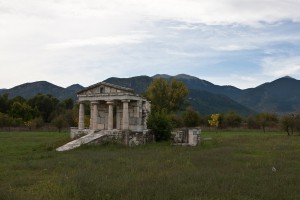 The most important monuments that the visitor to the archaeological site of Mantineia can see are the ancient theatre, the Bouleftirion, parts of the ancient Agora, Roman baths and a temple which was dedicated to Artemis Mesopolitis. Across the archaeological site one can also visit the Christian church of Aghia Fotini, a combination of Byzantine and Greek architecture, the aesthetics of which are a source of conflicting opinions.
The most important monuments that the visitor to the archaeological site of Mantineia can see are the ancient theatre, the Bouleftirion, parts of the ancient Agora, Roman baths and a temple which was dedicated to Artemis Mesopolitis. Across the archaeological site one can also visit the Christian church of Aghia Fotini, a combination of Byzantine and Greek architecture, the aesthetics of which are a source of conflicting opinions.
Regarding the preserved monuments, our best source of information is the traveller Pausanias, who visited the city around 170 A.D. and refers to them in detail. The archaeological site begins from the hill Gortsouli, where the acropolis of ancient Mantineia was located. From the top of this hill the visitor has a great, panoramic view of the whole valley of Mantineia, with the remains of the ancient city.
Video by fabdrone
 The ancient city of Mantineia is situated approximately 14 kilometres north of Tripoli, at Palaiopoli, one of the largest, most important and best preserved cities of the ancient world. Pausanias reports that Mantineas was the city’s legendary settler, grandson of Pelasgus, primogenitor of the Arcadians. The city is also mentioned by Homer, who calls it Mantinei eratinei, meaning “beloved land”. As this ancient reference reveals, Mantineia was a city already at its peak during the Archaic period, playing an important role in the events, not only of Arcadia, but of the entire ancient world.
The ancient city of Mantineia is situated approximately 14 kilometres north of Tripoli, at Palaiopoli, one of the largest, most important and best preserved cities of the ancient world. Pausanias reports that Mantineas was the city’s legendary settler, grandson of Pelasgus, primogenitor of the Arcadians. The city is also mentioned by Homer, who calls it Mantinei eratinei, meaning “beloved land”. As this ancient reference reveals, Mantineia was a city already at its peak during the Archaic period, playing an important role in the events, not only of Arcadia, but of the entire ancient world.
The first excavations in the region started between 1887 and 1889 by the French Archaeological School, led by Gustave Fougères, and they brought to light the Ancient Agora. Later excavations were undertaken in 1960 by the Greek Archaeological Service and revealed even more relics of this glorious city. The testimony of traveller Pausanias, who visited the city around 170 AD, helped in the identification of these discoveries as the main temples and public buildings of the city.
Mantineia had an impressive fortification wall, the agora, a theatre from the early Hellenistic times, a bath complex dating to the Roman period, the bouleuterion, a temple of Artemis Mesopolitis, as well as two temples which were possibly related to the worship of Zeus and Hera. Residences and tombs have also been located, but they are still well protected underground. Close to the archaeological site lies the Christian church of Saint Foteini, which combines Byzantine and Greek architecture. North of the ancient city, at a distance of approximately one kilometre, is the hill of Gortsouli, which has been identified as the administrative centre of the ancient city, known in ancient texts as Ptolis. A temple was discovered on this hill, which marks the beginning of the archaeological site.
Mantineia had significant presence and power in ancient times, also owing to its strategic position. Its perpetual competitor was Sparta; both cities claiming control of the wider region. This competition resulted in the city’s first destruction in 385 BC, by Agesipolis, King of Sparta. The residents then abandoned their destroyed homeland and scattered into the surrounding areas until 370 BC, when the city was re-established by the Theban general, Epameinondas. In 223 BC the city was destroyed once again by the Macedonian king Antigonos C who, together with his Achaean allies, conquered and looted the city, and massacred its population. The city was again rebuilt in 221 BC under a different name: it was named Antigonia, from the Macedonian king. It kept this name for some centuries, before the Emperor Hadrian gave it back its original name.
Source: www.mythicalpeloponnese.gr
Every August, hundreds of people visit the picturesque and traditional settlement of Karytaina on the occasion of the bazaar which is annually organized by the local women’s association. This bazaar usually lasts for 3 days and gives the women of Karytaina the opportunity to present various traditional products, like weavings, embroideries, as well as food and pastries, all handmade with love and care. The association also has a store in the centre of the village, which is open throughout the year and sells handmade products of exceptional quality.
Source: www.mythicalpeloponnese.gr
Ten kilometres outside Tripoli, next to the village of Alea, in Mantineia, stands imposingly the ancient city of Tegea, fragments of which started emerging from the end of the previous century. Tegea was one of the most important cities of ancient Arcadia, with a remarkable course through the centuries, until 395 A.D., when it was completely destroyed by the Goths and subsequently abandoned.The excavations have thus far uncovered part of its ancient theatre, part of the ancient Agora, an altar for emperor worship, an early-Christian basilica and fragments of a Byzantine settlement. The area today can be visited and operates as an archaeological park. Nearby there is also the Archaeological Museum of Tegea, with findings mainly from the area around the sanctuary of Athena Alea, patron of Tegea. This sanctuary is no longer extant, it is said, however, that fragments from it were used to build the church of Panaghia, located near the archaeological site.
Tegea was one of the most significant cities of ancient Arcadia. It was founded by Tegeates, son of Lycaon and grandson of Pelasgus, and it was the last seat of the mythical kings of Arcadia. Tegea flourished during antiquity; it is said to have had several thousands of citizens, and it struck its own coins – an indication of its prosperity. The city was destroyed in 395 AD by the Goths, which led to its final decline.
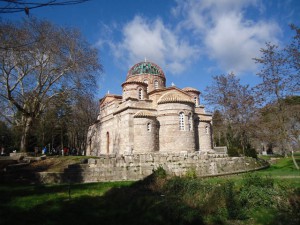 The temple of Alea Athena dominated the city, designed by the sculptor Skopas of Paros. Inside it stood an ivory statue of Athena, as well as statues of Asclepius and Hygeia, and the tusks of the Erymanthian Boar, which were taken to Rome when the city became part of the Roman Empire. According to mythology, the name “Alea” came from Aleus, the grandson of Arcas, who built the temple of the goddess Athena, protectress of Tegea. This temple no longer exists, but it is believed that parts were used to build the Christian church of Panagia, situated close to the archaeological site.
The temple of Alea Athena dominated the city, designed by the sculptor Skopas of Paros. Inside it stood an ivory statue of Athena, as well as statues of Asclepius and Hygeia, and the tusks of the Erymanthian Boar, which were taken to Rome when the city became part of the Roman Empire. According to mythology, the name “Alea” came from Aleus, the grandson of Arcas, who built the temple of the goddess Athena, protectress of Tegea. This temple no longer exists, but it is believed that parts were used to build the Christian church of Panagia, situated close to the archaeological site.
The excavations carried out at the site, initially by the French Archaeological School, and more recently by the Ephor of Antiquities, Theodoros Spyropoulos, brought to light temples of Athena Polias and Aphrodite, as well as a number of other buildings, such as the gymnasium, the agora, the stoa, the theatre, the stadium and the boule. Two paleo-Christian basilicas, an imperial cult altar and parts of a Byzantine village were also discovered in the area, from later periods. Only part of the one basilica is preserved, the so-called Thyrsos Basilica; the other is completely gone. The Norwegian Institute has been carrying out excavations since the 1990s, helping to identify buildings and roads in order to form a more complete picture of the area, while it also brought to light other findings, dating from the Byzantine periods and late antiquity.
The area today is an archaeological park of particular importance, with its own museum exhibiting the findings from the area.
Source: www.mythicalpeloponnese.gr
The Mansion of Herod Atticus is one of the most important and most impressive monuments in Arcadia. It is situated in Eva, in Doliana, an ancient town of Kynouria, which has been completely lost, but for a few samples of habitation. The mansion’s location was already known from the 19th century, however it was identified with certainty in 1906 by archaeologist Constantine Romeos.
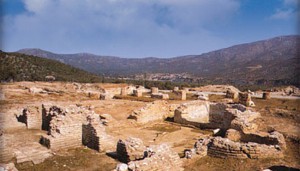 Herod Atticus, orator, philosopher and politician from a wealthy family, was also a fanatical collector of works of art. From his father he inherited a small mansion in Eva, which he decided to expand and to house his vast collection there, turning it into a sort of luxury museum. The mansion takes up approximately 20,000 m2 and includes a villa, a sanctuary, baths and a large atrium with galleries. The most impressive of all, however, are the mosaic floors; the total expanse of those discovered so far exceeds 1,300 m2. As the excavations and the research continue, it is very possible that others will come to light as well.
Herod Atticus, orator, philosopher and politician from a wealthy family, was also a fanatical collector of works of art. From his father he inherited a small mansion in Eva, which he decided to expand and to house his vast collection there, turning it into a sort of luxury museum. The mansion takes up approximately 20,000 m2 and includes a villa, a sanctuary, baths and a large atrium with galleries. The most impressive of all, however, are the mosaic floors; the total expanse of those discovered so far exceeds 1,300 m2. As the excavations and the research continue, it is very possible that others will come to light as well.
Unfortunately, before the regular excavations, a great part of the mansion’s treasures was destroyed due to ignorance, a fate which has befallen a great percentage of our cultural heritage.
Herodes Atticus (103-179 AD) was one of the most significant personalities of the Roman era in Greece. He was born into a rich family, which gave him the freedom to cultivate a multitude of interests and talents: he became an orator, philosopher and politician, while at the same time a prominent art collector, creating one of the most admirable collections of his time with rare and noteworthy works. From his father, Atticus, he inherited a small villa in Eva, Doliana, an ancient city of Kynouria situated close to the Loukous Monastery. Only few remnants of this city survive today. When Herodes completed his studies in Rome and Athens, he moved into this villa, impressed by the region’s rich history. It was the right place to house his rich collection, creating in this way a type of museum for ancient art, which was quite impressive in terms of its quality.
The location of the villa was known back in the 19th century, when English traveller William Martin Leake pointed it out. In the middle of the century, the area was visited by Ernst Gurtius, who noted that the ruins did not belong to some settlement, but to a villa. Archaeological findings were already bountiful in the area; according to the testimony of the monks of the adjacent Loukous Monastery, they would continually uncover antiquities while cultivating their land. The villa was identified in 1906 by Konstantinos Romaios, while systematic excavations started in 1979 by Theodoros Spyropoulos and continue to this day. The findings that have come to light are kept at the Archaeological Museums of Tripoli and Astros.
The Villa of Herodes Atticus covered a large area of 20,000 square metres, the largest villa in the Greek territory, following the Roman architecture style. It included a mansion, an atrium with galleries, a bath complex and a sanctuary. The archaeological findings that have come to light in fact verify the stories that this villa was a true museum. A number of sculptures, inscriptions and architectural parts have been revealed, most impressive of all, however, being the mosaic floors in various areas of the villa, with decoration, scenes and colours of high art. Currently, a large part of these mosaics has been uncovered, and future excavations are anticipated to reveal much more.
The villa unfortunately sustained repeated damage over the centuries, either owing to natural factors, or to raids and barbaric attacks, or even worse, to human indifference. The period of systematic excavations thankfully put an end to the lawless activities taking place in the region. Now it only remains for the villa to reveal its untold treasures lying hidden deep inside the earth.
Source: www.mythicalpeloponnese.gr
Ancient Gortys is among the most important Arcadian cities of the ancient world. The exact dates of its founding, prime and decline are not known, since the archaeological evidence that has come to light is not enough to make an estimation. It is generally accepted, however, that the city was in its prime already in the 4th century B.C., and it was probably destroyed sometime around the 12th century.
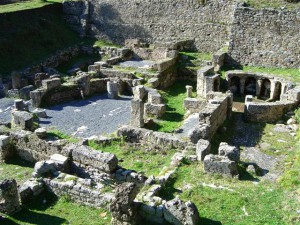 The archaeological site is located outside the village of Atsilochos, in Mountainous Arcadia. Remnants that have come to light include fragments of the old fortification, ruins of houses and public buildings, a sanctuary of Asclepius and baths that were probably connected to this deity, with a curative purpose. The baths are among the most important ones to be discovered from the ancient world. They included a special heating system, which was considered by the researchers to be an Arcadian innovation.
The archaeological site is located outside the village of Atsilochos, in Mountainous Arcadia. Remnants that have come to light include fragments of the old fortification, ruins of houses and public buildings, a sanctuary of Asclepius and baths that were probably connected to this deity, with a curative purpose. The baths are among the most important ones to be discovered from the ancient world. They included a special heating system, which was considered by the researchers to be an Arcadian innovation.
The city also seems to be connected with the ancient city of the same name located in the valley of Mesara, near Heraklion, Crete. It is very possible that the Cretan Gortys was created by inhabitants of the Arcadian one.
According to myth, Ancient Gortys was founded by Gortys, the brother of Agamedes, son of Stymphalus and great grandson of King Arcas of the Lycaonides people. He gave his name to the city and also to River Lousios, which is called Gortynios at the stretch from Gortynia up to its confluence with river Alfeios. In antiquity, it was one of the most important cities of Arcadia and, according to what little is known, one of the oldest.
The city is situated next to River Lousios, at an altitude of 350 metres, a short distance outside the village of Atsilochos, in mountainous Arcadia. It was one of the stops on the route followed by Spartan athletes when travelling to compete in the Olympic Games, as the ancient road of Olympia – Megalopolis – Mycenae – Isthmus – Athens passed through here.
The city was guarded by two acropolises with strong fortifications, built close to one another, at an altitude of approximately 480 metres. It also had several temples and public buildings, burial grounds, a sanctuary of Asclepius, as well as two large baths, which formed an integral part of the worship of this deity. The baths operated from the 2nd century BC and had a special heating system, which archaeologists believe was an Arcadian invention. There was also a temple dedicated to Asclepius containing the god’s cult statue made by the famous sculptor Skopas of Paros. So renowned was this temple, according to Pausanias, that even Alexander the Great visited it in 335 BC, offered a sacrifice to the god and dedicated his spear and chest armour.
The exact date of the foundation of ancient Gortys is not known, owing principally to the lack of relevant written evidence and findings. There are, however, findings dating to the Late Helladic (1600-1100 BC) and up to the Geometric Period (11th – 8th century BC), thus verifying its age. The city’s most important period is placed during the Classical and Hellenistic Periods, with its peak specifically around the 4th century BC. Its decline, on the other hand, appears to have come after the foundation of Megali Polis, in 368 BC, when Gortys, together with neighbouring cities, was forced to unite with it, thus losing its autonomy. As a result, a large part of its population relocated to the new city. The city appears to have been finally destroyed around the 12th century AD, during the Byzantine Period, by the Goths.
During its peak years however, Gortys was a lively city, participating in the events of the wider region throughout its history.
Source: www.mythicalpeloponnese.gr
Every year since 1995, the “Epidaurus Festival” is organized, offering the visitor the opportunity to watch various performances at the imposing ancient theater of Epidaurus. So if you love ancient drama, you must visit this picturesque theater especially on a cool Friday or Saturday night under the moonlight. While it gets dark, you will be able to enjoy the amazing lyrics of the ancient dramatists played by the best and most talented actors.
Source: www.mythicalpeloponnese.gr
During the beautiful, magical nights in end June every little romantic corner of Nafplion is filled with beautiful sounds and melodies coming from the “Naflpion Festival”. Come and join us in this unforgettable musical journey.
Source: www.mythicalpeloponnese.gr

